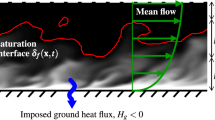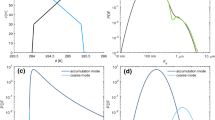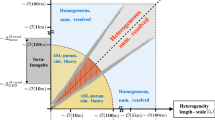Abstract
The Prandtl-layer concept, assuming constant turbulent fluxes in the lowest meters or decameters of the atmosphere under horizontal homogeneous and steady-state conditions, is widely used; and it is also one of the fundamentals of Monin-Obukhov similarity theory. Thus, surface-layer condensation processes-essentially formation of shallow fog layers-implying convergence and divergence of turbulent fluxes of water vapour, liquid water content and sensible heat, cannot be treated within this concept. This paper tries to overcome this restriction by a modified Monin-Obukhov theory, which deals with constant fluxes of total water content and moist static energy (instead of water vapour and sensible heat). It shows that surface-layer fog situations (under steady-state and horizontally homogeneous conditions and neglecting radiational effects) can be treated by this modified theory, which yields turbulent vertical fluxes of sensible heat, water vapour and liquid water content and their divergences.
The paper also derives a simple formula for the divergence of the turbulent flux of water vapour (∂E/∂z) under saturation conditions, which elucidates convergence ofE very close to the ground and divergence ofE higher up independent of whether the stratification is stable or unstable, i.e., whether there is fog over cold or warm ground. Model computations with the modified Monin-Obukhov theory are in full accordance with this formula. Thus a steam-fog case can be given as a demonstration of vertical profiles of turbulent fluxes of sensible heat, water vapour and liquid water content and their divergences.
Similar content being viewed by others
References
Brown, R. and Roach, W. T.: 1976, ‘The Physics of Radiation Fog: II—A Numerical Study’,Quart. J. R. Meteorol. Soc. 102, 335–354.
Brown, R.: 1980, ‘A Numerical Study of Radiation Fog with an Explicit Formulation of the Microphysics’,Quart. J. R. Meteorol. Soc. 106, 781–802.
Businger, J. A.: 1986, ‘Evaluation of the Accuracy with which Dry Deposition Can Be Measured with Current Micrometeorological Techniques’,J. Climate and Appl. Meteorol. 25, 1100–1124.
Kramm, G.: 1989, ‘A Numerical Method for Determining the Dry Deposition of Atmospheric Trace Gases’,Boundary-Layer Meteorol. 48, 157–175.
Kraus, H. and Schaller, E.: 1978, ‘Steady-State Characteristics of Inversions Capping a Well-Mixed Planetary Boundary Layer’,Boundary-Layer Meteorol. 14, 83–104.
Monin, A. S.: 1967,Ac. Sci. USSR, Doklady 175 (4), 819–822.
Monin, A. S. and Yaglom, A. M.: 1971, ‘Statistical Fluid Mechanics: Mechanics of Turbulence’. Volume 1 (of the English translation). The MIT Press.
Murray, F. W.: 1967, ‘On the Computation of Saturation Vapor Pressure’,J. Appl. Meteorol. 6, 203–204.
Schubert, W. H.: 1976, ‘Experiments with Lilly's Cloud Topped Mixed Layer Model’,J. Atmos. Sci. 33, 436–446.
Yaglom, A. M.: 1977, ‘Comments on Wind and Temperature Flux-Profile Relationships’,Boundary-Layer Meteorol. 11, 89–102.
Author information
Authors and Affiliations
Rights and permissions
About this article
Cite this article
Kraus, H. Surface-layer fog considered using a modified Monin-Obukhov theory. Boundary-Layer Meteorol 66, 219–235 (1993). https://doi.org/10.1007/BF00705475
Revised:
Issue Date:
DOI: https://doi.org/10.1007/BF00705475




